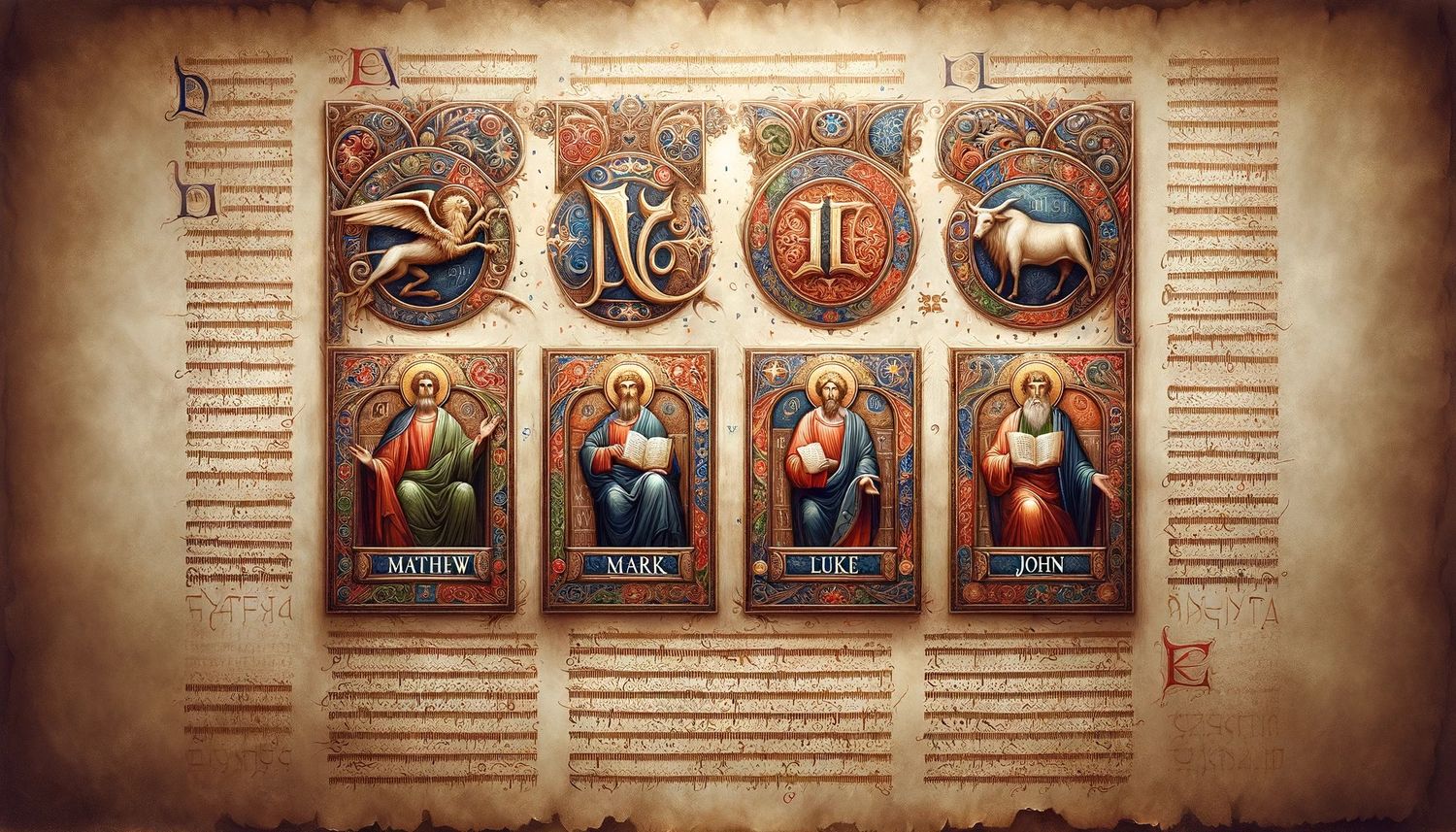Home>Christian Videos>Bible Stories>How To Read The Gospels Chronologically


Bible Stories
How To Read The Gospels Chronologically
Published: March 6, 2024
Ericka Andersen, an editor at Christian.net, expertly merges digital strategy with content creation, focusing on faith and societal issues. Her communication skills enhance the platform's engaging narratives, fostering meaningful dialogue on belief's impact on society.
Discover the chronological order of the Gospels and gain a deeper understanding of the Bible stories. Learn how to read the Gospels in sequence and uncover the interconnected narratives. Explore the significance of reading the Bible stories in their historical context.
(Many of the links in this article redirect to a specific reviewed product. Your purchase of these products through affiliate links helps to generate commission for Christian.net, at no extra cost. Learn more)
Table of Contents
Introduction
Have you ever wondered about the chronological order of the Gospels? The four Gospels in the New Testament—Matthew, Mark, Luke, and John—each provide a unique perspective on the life, teachings, death, and resurrection of Jesus Christ. While they share many similarities, they also present different details and events. Understanding the chronological order of the Gospels can provide a deeper insight into the life and ministry of Jesus. In this article, we will explore how to read the Gospels in chronological order, allowing us to follow the sequence of events in the life of Jesus Christ.
Read more: What Should I Read After The Gospels
Understanding the Chronological Order of the Gospels
Understanding the chronological order of the Gospels is essential for gaining a comprehensive view of the life and ministry of Jesus Christ. The Gospels were written by different authors at various times, and each author had a specific audience and purpose in mind. Matthew, Mark, and Luke are known as the Synoptic Gospels because they share many of the same stories, often in the same sequence. John, on the other hand, presents a more theological and reflective account of Jesus' life. When reading the Gospels in chronological order, it's important to consider the events and teachings in the context of the culture, geography, and historical timeline of the first century. By understanding the chronological order, we can appreciate the progression of Jesus' ministry and the fulfillment of prophecies concerning the Messiah.
To read the Gospels chronologically, it's helpful to harmonize the events and teachings found in each Gospel. This involves aligning the accounts of the same events and arranging them in the order they likely occurred. While the Gospels may not always provide precise chronological details, comparing the narratives can help create a cohesive timeline. Additionally, studying the historical and cultural context of the time period can provide valuable insights into the sequence of events. By examining the references to specific festivals, geographical locations, and political figures, we can piece together the chronological order of Jesus' life and ministry.
When exploring the chronological order of the Gospels, it's important to recognize the distinct perspectives and emphases of each Gospel writer. Matthew, writing primarily for a Jewish audience, emphasizes Jesus as the fulfillment of Old Testament prophecies and the rightful King of the Jews. Mark, likely recording the account of Peter, presents a fast-paced narrative focusing on Jesus' actions and miracles. Luke, a meticulous historian, provides a detailed and orderly account, often highlighting Jesus' compassion for the marginalized. John, writing with a theological purpose, emphasizes the divinity of Jesus and the significance of believing in Him for eternal life. Understanding these unique perspectives enriches our comprehension of the chronological order of the Gospels and the multifaceted nature of Jesus' life and teachings.
In summary, understanding the chronological order of the Gospels involves harmonizing the events and teachings, considering the historical and cultural context, and appreciating the distinct perspectives of the Gospel writers. By reading the Gospels in chronological order, we can gain a deeper understanding of the life, ministry, and significance of Jesus Christ.
The Birth and Early Life of Jesus
-
The Annunciation and Birth of Jesus: The chronological reading of the Gospels begins with the accounts of the annunciation of Jesus' birth to Mary by the angel Gabriel. Both the Gospels of Matthew and Luke provide details about the miraculous conception of Jesus by the Holy Spirit and His birth in Bethlehem. Matthew's Gospel emphasizes the fulfillment of Old Testament prophecies, highlighting Jesus as the promised Messiah and the descendant of David. Luke's Gospel offers a more detailed narrative, including the visitation of Mary to her relative Elizabeth, the birth of John the Baptist, and the angelic proclamation to the shepherds.
-
The Visit of the Magi and the Flight to Egypt: Following the birth of Jesus, Matthew's Gospel records the visit of the Magi, who came from the east to worship the newborn King of the Jews. Their journey and subsequent encounter with King Herod underscore the political implications of Jesus' birth. The Gospel also describes Joseph's dream, prompting the escape to Egypt to protect Jesus from Herod's wrath. This event highlights the fulfillment of prophecies and the divine protection surrounding Jesus' early life.
-
The Return to Nazareth: After the death of Herod, the Gospel of Matthew recounts Joseph, Mary, and Jesus' return from Egypt and their resettlement in Nazareth. This relocation fulfills the prophecy that Jesus would be called a Nazarene. Luke's Gospel also briefly mentions Jesus' upbringing in Nazareth, providing the backdrop for His early years and preparation for His future ministry.
-
The Boy Jesus in the Temple: Luke's Gospel offers a unique account of Jesus' early life, depicting an incident when He was twelve years old. During the Passover, Jesus remained in Jerusalem, astonishing the teachers in the temple with His understanding and answers. This episode reveals Jesus' wisdom and knowledge even at a young age, foreshadowing His divine mission and identity.
-
Significance of the Birth and Early Life: The chronological reading of the Gospels presents a cohesive narrative of Jesus' miraculous birth, divine protection, and formative years in Nazareth. These accounts establish the foundation for understanding Jesus' identity as the Son of God and the fulfillment of God's redemptive plan. The details surrounding His birth and early life underscore the prophetic significance and divine orchestration of His earthly existence, setting the stage for His public ministry and ultimate sacrifice for humanity's salvation.
Jesus' Ministry in Galilee
-
The Beginning of Jesus' Ministry: The chronological order of the Gospels highlights the commencement of Jesus' public ministry in the region of Galilee. This phase is marked by significant events such as the calling of the first disciples, including Peter, Andrew, James, and John, who were fishermen. The Gospels of Matthew, Mark, and Luke provide parallel accounts of Jesus' early teachings, healings, and the establishment of His authority as a teacher and miracle-worker.
-
Sermon on the Mount: One of the pivotal events during Jesus' ministry in Galilee is the delivery of the Sermon on the Mount, as recorded in the Gospel of Matthew. This profound discourse encompasses the Beatitudes, teachings on love for enemies, prayer, and the importance of building one's life on a solid foundation. The Sermon on the Mount encapsulates the ethical and moral teachings of Jesus, emphasizing the principles of the Kingdom of God and the transformative nature of His message.
-
Miracles and Healings: Throughout His ministry in Galilee, Jesus performed numerous miracles and healings, demonstrating His authority over sickness, nature, and spiritual forces. The Gospels depict instances of Jesus healing the sick, restoring sight to the blind, calming the storm, and even raising the dead. These miraculous acts served as tangible demonstrations of God's power and compassion, affirming Jesus' identity as the long-awaited Messiah.
-
Parables and Teachings: Jesus frequently utilized parables to convey profound spiritual truths to the crowds and His disciples. The parables of the sower, the mustard seed, the prodigal son, and the good Samaritan are among the many teachings that exemplify Jesus' use of everyday scenarios to illustrate eternal principles. His teachings in Galilee encompassed a wide range of topics, including the Kingdom of God, forgiveness, prayer, and the cost of discipleship.
-
Opposition and Rejection: Despite the impact of His ministry, Jesus encountered opposition and rejection, particularly from the religious leaders of the time. The Gospels portray instances where the Pharisees and scribes questioned Jesus' authority, criticized His association with sinners, and sought to test Him with challenging questions. The growing tension between Jesus and the religious establishment foreshadowed the escalating conflict that would culminate in His crucifixion.
-
Significance of Galilean Ministry: The chronological reading of the Gospels underscores the significance of Jesus' ministry in Galilee as a period of profound teaching, miraculous demonstrations, and the establishment of His authority. The events and teachings during this phase laid the groundwork for the expansion of the Kingdom of God, the training of His disciples, and the revelation of His divine identity. Jesus' ministry in Galilee serves as a pivotal segment in the chronological progression of the Gospels, shaping the narrative of His redemptive mission and the impact on those who encountered His transformative message.
Jesus' Ministry in Judea and Perea
-
The Journey to Judea and Perea: As Jesus' ministry progressed, He embarked on a significant journey from Galilee to the regions of Judea and Perea. This transition marked a pivotal phase in His earthly mission, expanding the scope of His teachings and interactions with diverse audiences. The Gospels portray Jesus' deliberate movement towards Jerusalem, the epicenter of religious and political significance, where the culmination of His ministry would unfold.
-
Encounters and Teachings: During His ministry in Judea and Perea, Jesus engaged in profound encounters and delivered teachings that addressed critical aspects of faith, salvation, and the Kingdom of God. The Gospel of John provides detailed accounts of Jesus' interactions, including the transformative conversation with Nicodemus about being born again, the encounter with the Samaritan woman at the well, and the healing of the official's son in Capernaum. These encounters exemplify Jesus' inclusive ministry, transcending cultural and social barriers to offer the message of hope and redemption to all.
-
The Feast of Tabernacles and the Temple Teaching: The Gospel of John records Jesus' presence at the Feast of Tabernacles in Jerusalem, where He delivered profound teachings, declaring Himself as the "light of the world" and offering living water to those who believe in Him. His teachings sparked intense debates and divisions among the people, reflecting the profound impact of His words and the growing recognition of His authority as the promised Messiah.
-
The Raising of Lazarus: One of the most poignant events during Jesus' ministry in Judea was the raising of Lazarus from the dead, as documented in the Gospel of John. This miraculous demonstration of power over death not only affirmed Jesus' divine authority but also foreshadowed His impending sacrificial death and resurrection. The raising of Lazarus elicited varied responses, leading to an escalation of opposition from the religious leaders who perceived Jesus as a threat to their authority.
-
The Final Journey to Jerusalem: As Jesus' ministry in Judea and Perea unfolded, the Gospels depict His deliberate journey towards Jerusalem, where the climactic events of His crucifixion and resurrection would transpire. The anticipation of His arrival in Jerusalem set the stage for the fulfillment of prophetic significance and the ultimate purpose of His redemptive mission.
-
Significance of Judean and Perean Ministry: The chronological progression of the Gospels highlights the significance of Jesus' ministry in Judea and Perea as a period of profound encounters, transformative teachings, and the intensification of opposition. The events and interactions during this phase underscored the universal scope of Jesus' message, the revelation of His divine identity, and the imminent fulfillment of God's redemptive plan. Jesus' ministry in Judea and Perea serves as a crucial segment in the chronological narrative, shaping the trajectory of His sacrificial mission and the profound impact on those who witnessed His profound ministry.
Read more: Where Can One Read The Gnostic Gospels?
The Final Week of Jesus' Life
-
The Triumphal Entry into Jerusalem: The final week of Jesus' life, often referred to as the Passion Week, commenced with His triumphant entry into Jerusalem. This event, commonly known as Palm Sunday, fulfilled the prophecy of Zechariah, as Jesus rode into the city on a donkey while the crowds hailed Him as the long-awaited Messiah. The atmosphere was charged with anticipation as Jesus was welcomed with shouts of "Hosanna," signifying the people's recognition of Him as the promised King.
-
Cleansing of the Temple: Upon entering Jerusalem, Jesus proceeded to the temple and overturned the tables of the money changers, denouncing the commercial activities that had defiled the sacred space. This bold action demonstrated His authority and zeal for the purity of God's house, emphasizing the spiritual significance of the temple as a place of prayer and worship.
-
Teachings and Controversies: Throughout the final week, Jesus engaged in profound teachings and contentious interactions with the religious leaders. He delivered parables, including the parable of the wicked tenants, which conveyed the impending consequences of rejecting God's messengers, culminating in the rejection of His Son. Jesus also confronted the hypocrisy and spiritual blindness of the religious authorities, exposing their oppressive practices and lack of genuine faith.
-
The Last Supper: One of the most significant events during the final week was the Last Supper, where Jesus shared a poignant meal with His disciples. During this intimate gathering, He instituted the sacrament of communion, symbolizing His impending sacrifice and the establishment of the new covenant through His body and blood. Jesus also washed the feet of His disciples, demonstrating servanthood and imparting a profound lesson on humility and love.
-
The Agony in Gethsemane: Following the Last Supper, Jesus retreated to the Garden of Gethsemane, where He grappled with the weight of His impending crucifixion. In a moment of profound anguish, He prayed to the Father, expressing His willingness to fulfill the divine plan while seeking strength to endure the impending ordeal. This poignant episode revealed the depth of Jesus' humanity and His submission to the Father's will.
-
The Betrayal, Trial, and Crucifixion: The final week culminated in the betrayal of Jesus by Judas Iscariot, leading to His arrest and subsequent trials before the religious and Roman authorities. Despite the unjust accusations and mockery, Jesus remained resolute in fulfilling His redemptive mission. The events unfolded with His crucifixion on the cross at Golgotha, where He bore the sins of humanity, offering salvation and reconciliation with God.
-
The Resurrection and Ascension: The final week of Jesus' life reached its climactic resolution with His resurrection from the dead on the third day, triumphing over sin and death. His appearances to the disciples and followers affirmed the reality of His victory and the fulfillment of the Scriptures. The culmination of His earthly ministry concluded with His ascension into heaven, marking the exaltation of the crucified Messiah and the commissioning of His followers to proclaim the gospel to all nations.
In summary, the final week of Jesus' life encapsulates the profound events and teachings that culminated in His sacrificial death and triumphant resurrection. This pivotal period not only fulfilled the prophetic promises but also established the foundation of the Christian faith, offering redemption, hope, and eternal life through the life, death, and resurrection of Jesus Christ.
The Resurrection and Ascension
The final week of Jesus' life reached its climactic resolution with His resurrection from the dead on the third day, triumphing over sin and death. His appearances to the disciples and followers affirmed the reality of His victory and the fulfillment of the Scriptures. The culmination of His earthly ministry concluded with His ascension into heaven, marking the exaltation of the crucified Messiah and the commissioning of His followers to proclaim the gospel to all nations.
The resurrection of Jesus stands as the central and defining event of the Christian faith. The Gospels provide vivid accounts of the empty tomb, the encounters with the risen Christ, and the transformation of the disciples from despair to unwavering conviction. The resurrection validated Jesus' claims, affirmed His victory over death, and inaugurated a new era of hope and redemption for humanity.
Following His resurrection, Jesus appeared to His disciples, providing irrefutable evidence of His triumph over the grave. These encounters dispelled doubt, instilled courage, and solidified the foundation of the early Christian community. The resurrection appearances not only affirmed the reality of Jesus' victory but also demonstrated the continuity of His mission and the fulfillment of God's promises.
The culmination of Jesus' earthly ministry occurred with His ascension into heaven, marking the consummation of His redemptive work and the establishment of His eternal reign. The ascension affirmed His exaltation and enthronement at the right hand of God, signifying His authority over all creation. As Jesus ascended, He imparted the promise of the Holy Spirit and commissioned His disciples to proclaim the gospel to the ends of the earth, empowering them to continue His mission with divine enablement.
The significance of the resurrection and ascension extends beyond historical events; they embody the core tenets of the Christian faith. The resurrection affirms the hope of eternal life, the defeat of sin and death, and the assurance of God's redemptive power. The ascension underscores Jesus' sovereignty, intercessory role, and the promise of His return. These pivotal events not only validate the identity and mission of Jesus but also provide the foundation for the believer's confidence, purpose, and anticipation of His imminent return.
In summary, the resurrection and ascension of Jesus Christ represent the culmination of His redemptive mission, affirming His victory over sin and death and establishing the foundation of the Christian faith. These transformative events resonate with profound significance, offering hope, assurance, and the promise of His imminent return.
Conclusion
In conclusion, reading the Gospels chronologically provides a comprehensive understanding of the life, teachings, death, and resurrection of Jesus Christ. By harmonizing the events and teachings, considering the historical and cultural context, and appreciating the distinct perspectives of the Gospel writers, readers can gain a deeper insight into the multifaceted nature of Jesus' life and ministry. The chronological order of the Gospels allows for a cohesive narrative that unveils the prophetic significance, divine orchestration, and redemptive purpose of Jesus' earthly existence. From the miraculous birth and early life to the culmination of His sacrificial mission, the Gospels present a compelling account of the transformative impact of Jesus' ministry and the enduring significance of His resurrection and ascension. Ultimately, reading the Gospels chronologically offers a profound journey through the life of Jesus Christ, inviting readers to encounter the timeless truths and eternal hope found in the person and work of the Son of God.














